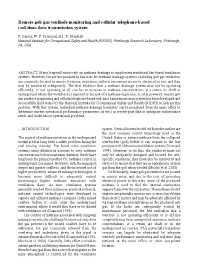Mining Publication: Remote Gob Gas Venthole Monitoring and Cellular Telephone-Based Real-Time Data Transmission System
Original creation date: October 2002
Many longwall mines rely on methane drainage to supplement traditional fan-based ventilation systems. However, the surface production facilities for methane drainage systems, including gob gas ventholes, are commonly located in remote locations, sometimes without convenient access to electrical power, and they may be monitored infrequently. The first evidence that a methane drainage system may not be operating efficiently, or not operating at all, can be an increase in methane concentrations at a return air shaft or underground where the workforce is exposed to the risk of a methane explosion. A solar powered, remote gob gas venthole monitoring and cellular telephone-based real-time data transmission system has been developed and successfully field tested by the National Institute for Occupational Safety and Health (NIOSH) to address this problem. With this system, individual methane drainage boreholes can be monitored from the mine office to determine current operational performance parameters, as well as review past data to anticipate maintenance needs and troubleshoot operational problems.
Authors: F Garcia, WP Diamond, JK Marshall
Conference Paper - October 2002
NIOSHTIC2 Number: 20023125
Proceedings of the North American/Ninth U.S. Mine Ventilation Symposium, De Souze E, ed. (Kingston, Ontario, Canada). Lisse, Netherlands: Balkema, 2002; :324-329
See Also
- Computational Fluid Dynamics Study on the Ventilation Flow Paths In Longwall Gobs
- Improved Methods for Monitoring Production From Vertical Degasification Wells
- Optically Powered Remote Gas Monitor
- Prediction of Porosity and Permeability of Caved Zone in Longwall Gobs
- Rapid (Grab) Sampling During Full-scale Explosions - Microscopic and Analytical Evaluation
- Strategies to Reduce Miners Exposure to DPM and Gases (Elko)
- Strategies to Reduce Miners Exposure to DPM and Gases (Reno)
- Technology News 490 - An Inexpensive Device for Monitoring Explosions in Sealed Areas of Underground Mines
- A Technology Review of Smart Sensors with Wireless Networks for Applications in Hazardous Work Environments
- Underground Mine Communications, Control and Monitoring
- Page last reviewed: 9/21/2012
- Page last updated: 9/21/2012
- Content source: National Institute for Occupational Safety and Health, Mining Program


 ShareCompartir
ShareCompartir
